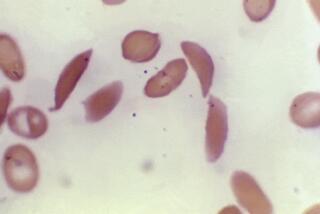DNA study finds many genetic mutations are rare and recent
Human DNA contains myriad individual differences that influence a host of traits, be they eye color or the ability to digest milk. Now a study shows that most of those tiny genetic variations are rare — and they arose in the very recent history of our species.
Joshua Akey, a geneticist at the University of Washington in Seattle, led a consortium of scientists who examined the DNA of 4,298 European Americans and 2,217 African Americans. Limiting their analysis to the parts of the genome that contain instructions for making proteins, the study authors found more than 1 million sites where the building blocks of DNA — the nucleotides known by the letters A, C, G and T — varied in at least one of the subjects.
Most of those individual variants were rare, with each one found in fewer than 0.5% of the people in the sample. In nearly half of the cases of mutations, each variant was detected in only one person, according to their report last month in the journal Nature.
This meant that the genetic changes must have cropped up very recently, because otherwise there would have been ample time for them to spread through generations of people and show up in many more of the study participants, the authors said.
The scientists were even able to estimate the age of variations based on how rare or common they were — and found that about 73% of the mutations had occurred in the last 5,000 to 10,000 years.
The percentage of rare — and therefore recent — mutations was greater in European Americans than African Americans, the team reported. That fits with the history of Homo sapiens: The ancestors of Europeans went through explosive population growth when they left their homeland in Africa tens of thousands of years ago.
The scientists also tried to gauge the likelihood that these mutations would influence someone’s risk for disease and other traits. If a gene region had exactly the same structure in humans, apes and other vertebrates, they reasoned, it must be important; any changes there would thus be more likely to harm. So would any mutation that would alter the properties of a protein.
These mutations were even more likely to be recent: Fully 86% of them arose within the last 5,000 to 10,000 years.
It’s not really surprising that the more-likely-to-be-harmful mutations would be rare and recent, Akey said. Any mutation that was truly toxic would quickly be weeded out from a population, and even those that were merely damaging would reduce a person’s chances of passing on their genes, so they would disappear eventually too.
The results give a sense of just how quickly the human population has expanded in the last 10,000 years — and how that has affected our genetic makeup, said Shamil Sunyaev, a computational geneticist at Brigham and Women’s Hospital in Boston who wasn’t involved in the study. Without that population explosion, there would have been fewer chances for mutations to occur and the proportion of recent mutations would not have been so high.
There is a practical lesson as well, Akey added. In recent years, medical researchers have been working hard to find patterns of common genetic mutations that are linked to common diseases. Maybe they need to focus more attention on the rare mutations instead, he said.
The study is “really the first to get at this in a fashion you’d like to see — with large data sets and lots and lots of people,” said Stanford University geneticist Michael Snyder, who wasn’t involved in the study.
Snyder added that you can see such mutations accruing in recent studies that have shown, in families with autistic children, for example, that many affected children carry brand-new DNA changes that arose spontaneously in a parent.
More to Read
Start your day right
Sign up for Essential California for news, features and recommendations from the L.A. Times and beyond in your inbox six days a week.
You may occasionally receive promotional content from the Los Angeles Times.






